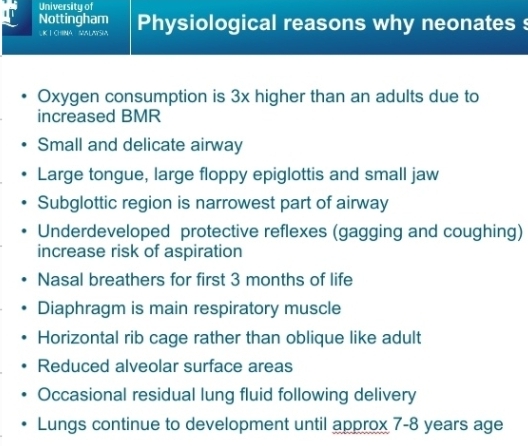respiratory issues in fetus
1/15
There's no tags or description
Looks like no tags are added yet.
Name | Mastery | Learn | Test | Matching | Spaced |
|---|
No study sessions yet.
16 Terms
why do respiratory issues occur in the newborn?
lungs need to go from fluid filled & compact to air filled
airway resistance needs 2 decrease in other for the functional residual capacity 2 increase (how easily the baby can breathe)
blood pressure in the lungs needs to fall (which supports the oxygenation)
what are the common respiratory problems?
transient tachypnoea of the newborn
persistent pulmonary hypertention of the newborn
meconium aspiration syndrome
respiratory distress syndrome (RDS)
transient tachypnoea (shallow quick breathing) of the newborn
lungs are not fully cleared of the fluid at birth
causing problems with gas exchange
persistent pulmonary hypertention of the newborn
blood pressure doen’t fall causing issues with oxygination, gas exchange and blood supply
meconium aspiration syndrome
if baby breathes meconium stained fluid before being fully delivered
baby can aspirate & develop aspiration pneumonia
respiratory distress syndrome (RDS)
caused by deficiency in surfactant
mainly affects pre-term but can affected babies from diabetic mum or babies that develop asphyxia (02 deprivation)at birth
what is curosurf
artificial surfactant
baby must be intubated
what is surfactant
fat-based layer that lines the airway preventing the lungs from sticking together
produced by type 2 alveolar cells- fully by 28 wwks (not mature until 34 wwks)
who are surfactants given to
neonates with RDS or other respiratory distress conditions
“ “ < 32 wwks
“ “ needing >40% 02
respiratory distress signs
range outside of 30-60 breaths x min
recessions (resistance to air entry is increased so the effort to inhale pulls immature muscles inwards)
nasal flaring
head bobbing
what causes tachypnia ?
> 60 bpm
(body conpensating for changes in blood gases & pH in body e.g. decreased 02, increased CO2)
respiratory assessment
take detailed history
observe chest at rest
check skin colour
check pattern of breathing - baby should breathe through nose
look out for symmetry of the chest (assymatry may indicate pneumothorax)
count resps & auscultate lungs (listen out for clear lungs)
think about why your concerned for this baby
unsual breathing
stridor - high pitched noise on inspiration
wheeze- variable pitch heard in expiration
grunting- sudden expiratory sound due to the glotts closing
crackles- short intermitted sounds during expiration
plerual rub- inflammed plerual noises
physiological reasons neonates struggle to breathe
small delicate airway
reduced alveolar surface area
residual lung fluid following delivery

what 2 do if baby is struggling to breathe
5 inflation breaths
listen to HR
(if HR still not up) inflation breaths again
3 cardiac pushes x 1 ventilation breath
what do antenatal steroids do ?
accelerate lung growth
enlarge alveoli